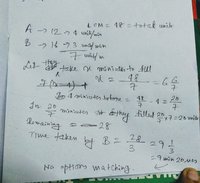Two pipes A and B can fill a tank in 12 and 16 minutes respectively. Both pipes are opened together but 4 minutes before the tank is full, pipe A is closed. In how many minutes will the tank be full?
Options:
1. 9 mins 8 secs
2. 10 mins 9 secs
3. 11 mins 19 secs
4. 11 mins 29 secs
Options:
1. 9 mins 8 secs
2. 10 mins 9 secs
3. 11 mins 19 secs
4. 11 mins 29 secs
Last edited by a moderator:

